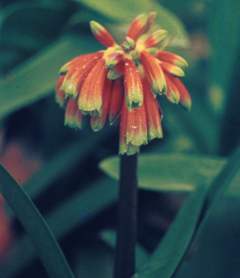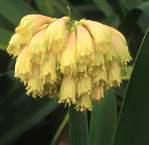Clivia nobilis
Clivia nobilis Lindl
Family: Amaryllidaceae
Common names: Eastern Cape clivia, Eastern Cape bush lily (Eng.); boslelie (Afr.); umayime (isiXhosa & isiZulu)
Introduction
Clivia nobilis was the first species of Clivia to be described in 1828. It was a popular plant in England until the more spectacular Clivia miniata appeared on the scene some 30 years later.

Description
Description
Clivia nobilis is an evergreen bulbous plant which develops a rhizome and forms a tight clump as new suckers are produced and the plant becomes larger.
In light shade the leaves are almost horizontal and are relatively short, approximately 300 mm in length, while in dense shade the leaves are fairly upright and grow to 800 mm in length. The width of the leaves can range from 25 to 50 mm. The leaves are a dull dark green, with some forms displaying a pale green stripe down the centre of the leaf similar to the stripe which occurs on the leaves of some C. mirabilis plants. The margins of the leaves on many plants are serrated and the leaf tips are rounded and often notched.

C. nobilis produces an inflorescence containing 40 to 60 pendulous cylindrical flowers ranging in colour from very pale to dark orange or orange-red with pale to dark green tips. There is also an unusual form with flowers that are very pale pinkish-yellow in the upper half and pale greenish-yellow in the lower half. It flowers between late autumn and spring. Flowers are followed by clusters of bright red berries the size of a marbles which take a year to ripen. The seed is round and about 6 mm in diameter.

The rate of growth of C nobilis is considerably slower than that of all other Clivia species. From seed C. nobilis takes at least 6 years or more to flower. Under favourable conditions this species is a long-lived plant and will outlive many generations.
Conservation Status
Status
According to the website http://redlist.sanbi.org checked on 20 January 2016 the conservation status of this plant is Vulnerable (VU). The population has declined by at least 30% in the last 120 years due to harvesting for the medicinal plant trade, horticultural acquisitions and some habitat destruction caused by coastal development.
Distribution and habitat
Distribution description
Clivia nobilis occurs as isolated populations on the east coast from Alexandria Forest near Port Elizabeth northwards to Hole-in-the-Wall (in former Transkei ). Occasional populations occur inland, with the most westerly population occuring in the Zuurberge up to an altitude of 600 m.
Coastal populations occur on dune sand, while forest and inland populations are found on river banks, on shale and rocky outcrops. Both coastal and inland populations have been found growing in both bush cover and with a high forest canopy. These differing light intensities affect the leaf length. Rainfall in the area ranges from 1000 mm to 1400 mm which occurs in summer. Temperatures range from as low as 3° C to 30° C; however the evergreen forests always have a cooling effect.
Derivation of name and historical aspects
History
Clivia nobilis was named by Lindley in honour of the Duchess of Northumberland, Lady Clive, who was the granddaughter of Clive of India. The plant was collected by William Burchell, a school teacher who arrived in Cape Town in 1810. He was fascinated by natural history and spent four years travelling in a covered wagon collecting herbarium specimens of plants. He collected a plant near Grahamstown which later turned out to be a new genus, Clivia.
There are in total 6 Clivia species — C. nobilis, C. miniata, C. caulescens, C. gardenii, the recently discovered C. mirabilis and C.robusta — all of which produce pendulous flowers, with the exception of C. miniata, the most striking of them all with large open flowers which vary in size, shape and colour.
Ecology
Ecology
Not a great deal is known about the pollination of C. nobilis. It is possible that the flowers are self-pollinating or wind-pollinated. However, the flowers produce copious amounts of nectar so bees and sunbirds could also be pollinators of this fascinating plant. Birds are known to distribute the seed. C. nobilis is a plant which requires very little water to survive.
Uses
Use
Unfortunately all Clivia species are harvested in their natural habitats for medicinal and magical uses, a practice which is destroying many populations of Clivia.
Clivia nobilis is not very well known horticulturally, possibly as it is so slow-growing and not as spectacular as C. miniata.
Growing Clivia nobilis
Grow
Light shade is an ideal situation for this species, with good drainage in a frost-free area. Ideal companion plants are Asparagus densiflorus, Crassula muticava, Clivia miniata and Veltheimia bracteata. Clivia nobilis is not deep-rooted, so plenty of compost applied as a mulch is most beneficial if applied once a year. In addition feed once a year with an organic fertilizer.

Propagate C. nobilis by sowing the seed once all the soft tissue has been removed from the berry. Sow the seed while fresh in a mixture of equal parts milled pine bark and sand. Cover lightly with milled pine bark. Once the seedlings are large enough to handle they need to be planted out into 15-cm pots. Three in each pot. Every 9 months they need to be repotted in fresh growing medium as the old medium breaks down and the drainage is impaired.
These plants can also be propagated by division using a sharp knife to separate each growing stem. Plant in the same medium as above. The divisions should flower within 2 years whilst your seedlings will take 6 or more years to flower.
Pests which occur in moist shady areas are slugs and snails and they do much damage to the young tender growths. Care must be taken to eliminate these pests. Another pest which can do much damage is the snout beetle. It is nocturnal and damages the leaves. A contact insecticide will eliminate this pest.
References
- Duncan, G.D. 1999. Grow clivias. Kirstenbosch Gardening Series. South African National Biodiversity Institute, Cape Town.
- Koopowitz, H. 2002. Clivias.Timber Press, Portland Cambridge
Credits
John Winter
Kirstenbosch National Botanical Garden
January 2006
Plant Attributes:
Plant Type: Bulb
SA Distribution: Eastern Cape
Soil type: Loam
Flowering season: Spring, Autumn
PH: Acid, Neutral
Flower colour: Green, Red, Orange
Aspect: Shade
Gardening skill: Easy
Special Features:
Horticultural zones









Rate this article
Article well written and informative
Rate this plant
Is this an interesting plant?
Login to add your Comment
Back to topNot registered yet? Click here to register.